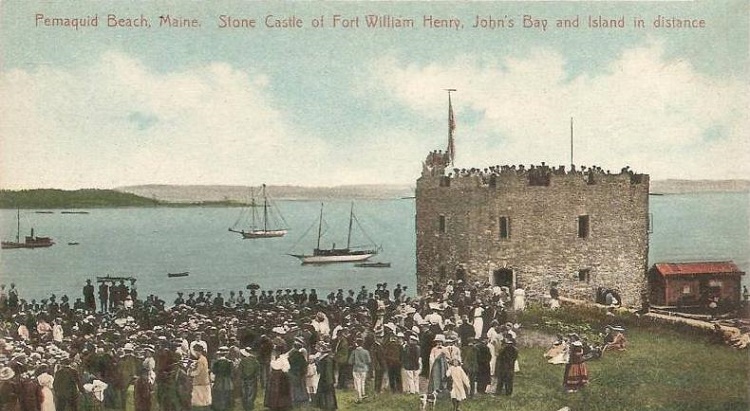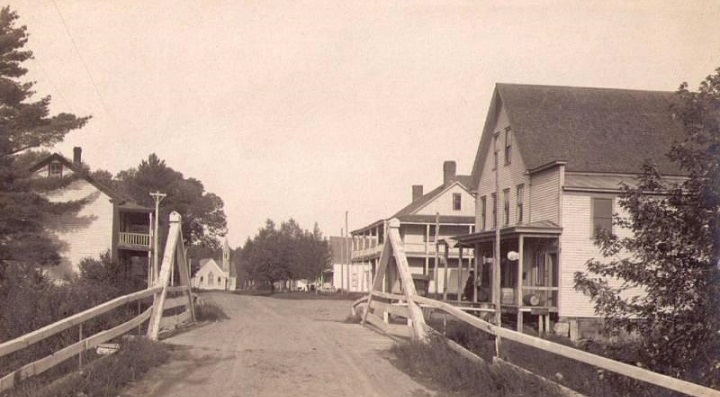When we talk about ghost towns in the United States most people think of the old ghost towns are found in the Old West. Really though, every state has ghost towns and Maine is no exception.
Maine is dotted with numerous ghost towns across the entire state. Most of the ghost towns originated in the industrial age with a few coming quite early. Some of them still have visible structures in place, while others are long gone.
These can be great places to hunt with a metal detector because they have such amazing history. Some very old coins and relics can still be found at Maine ghost towns.
Below are just a few of the interesting ghost towns that you can visit in Maine.
1. Fort William Henry, Maine
This town was established in the 1600s as a colonial fort. During its peak time, it was the largest colonial fort in New England and all the surrounding regions. The town was located in New Harbor village near the town of Bristol. The fort provided important communications to the surrounding environment.
The fort was constructed for the first time in 1630 as Abraham Shurte’s Fort by the British colonizers. It quickly grew into an important trading center before it was burned to ground in 1633 by Dixie Bull, an English pirate.
A new fort named Fort Pemaquid was constructed at the site and stood until 1676 when it was destroyed by French fighters during the King Philip’s War.

Again a new fort named Fort Charles was constructed on the site in 1677 but lasted for only 12 years before being destroyed in 1689 during the King William’s War.
The fourth fort named Fort William Henry was constructed on the site in 1692. Several attacks from natives forced the British to abandon the fort until 1729 when a new fort dubbed Fort Fredrick was built at the site. The fort was decommissioned in 1759 and the site abandoned until 1902 when the site was purchased for a state park.
Today, the most parts of Fort Henry lie in a state park. The most important part of the park is the reconstructed Fort Henry tower and foundations of most other structures from the 1600s.
2. Freeman, Maine
During the American Revolution, Maine was still part of the start of the Massachusetts. Back then Portland was still known as Falmouth. During the war with the British colonizers in 1775 Falmouth was burned to the ground by British bombs leaving many of its residents homeless. The government of Massachusetts created Freeman in 1797 to resettle the homeless people and provide relieve to people displaced by the war.
The town grew quickly reaching a population of about 1,000 people in 1840s. It was an important trading center for the neighboring farming communities. At its peak, that town had two railroad stations one in the North and the other in the South Freeman, ten school houses, two churches, general stores, hotels and many other businesses.
The town began its decline during the industrial revolution in America of the late 1800s and early 1900s. The lack of any major industry around the town forced most of the residents to move away in such of employment.
Due to the high rate of population decline the town was unincorporated in 1937. Today only the cemetery and few foundations of the early structures remain at the site of this historical town.
3. Madrid, Maine
The town of Madrid was established in the 1790s when settlers began buying tracks of land along the Sandy River. The town was incorporated in 1836 following a steady growth in population. Early settlers around the site of the town were farmers producing wheat and other crops. But soon lumber harvesting became an important activity in the town promoting the construction of three sawmills, two shingle machines, a gristmill and two clapboard factories around town. This helped bring in more people adding to the growth of the town.
When gold was discovered near the town in 1854 more and more people settled in the town making it an important commercial center in the area. At its peak, Madrid had seven school houses, a local newspaper, a rail station, two carriage makers, a hotel, several churches and many other businesses.
Madrid began its decline in the 1900s with a sharp population decline leading to its disincorporation in 2000. The last school in the town was closed in 1959 and the school building was used as the town hall until 2000.
Today only the two story school house, a church and a number of other buildings still stand at the site. The schoolhouse has been turned into a museum.
Also Read: Metal Detecting Maine – Coins, Relics & Buried Treasure
And: Where to Find Gold in Maine
4. Newhall, Maine
Newhall was established near Windham at the intersection of Gambo and River roads in the 1820s following the construction of powder works in the area. Lester Ladlin and Edmund Fowler began powder production at Gambo Falls in 1738 before shifting their operations to Newhall in 1824. This led to the growth of a town around the Powder factory locally known as the Gambo mills. The duo then sold their Operations in 1855 leading to the establishment of the Oriental Powder Company in 1859.
The town grew tremendously with the powder company as more and more powder was needed to help in the Civil War. At the height of the Civil War, the oriental powder company was one of the largest companies in Maine and the fourth-largest mill in the country.
With the end of the Civil War production declined and the company turned to producing powder for the mining industry and the railroad construction.
The Mill was sold to the Eastern Dynamite Company in 1895 then to the Atlas Powder Company in 1912 and continued operating until the end of the Second World War. After the mill was closed down for the last time in the late 1940s, the town began to decline as residents moved away in search of new employment.
Today the old Gambo Mill is part of the Shaw Park. The park is also home to several foundations and structures from the early days of the town.
5. Askwith, Maine
Askwith was settled in the early 1800s because the surrounding area was rich in game animals for hunting and timber for constructions. The rivers also had plenty of fish for the settlers.
The settlement quickly grew into a small town with its own post offices, a railroad station, a school, churches and numerous businesses. With better economic prospects elsewhere and especially the discovery of minerals in neighboring states most of the residents left in search of greener pasture. The town declined steadily and by 1930s the population had dropped to just 56.
Today nothing much is left of the town safe for the old decaying railroad station and the railroad which is currently an ATC trail.
6. Flagstaff, Maine

Flagstaff, Maine. Prior to being flooded by Flagstaff Lake on the Dead River.
Before 1950, Flagstaff was the largest town in the Dead River Valley. It was first a camping site for the British Army on their way to Quebec well before the revolution. The town began to grow at the site in the 1840s when Myles Standish built a grist mill and a sawmill at the site. This attracted more settlers to the area creating a small town.
In the 1930s and 1940s, the Central Main Power Company began buying lands around the Dead River Valley with an aim of increasing its power production. In the 1940s the company got approval to build a dam. This forced the residents of the Flagstaff town to leave the town.
Today the site of Flagstaff is under the lake. Glass bottom boat tours are available on the lake allowing people see the remaining homes beneath the Flagstaff Lake.
Next: Where to Pan for Gold in New Hampshire







